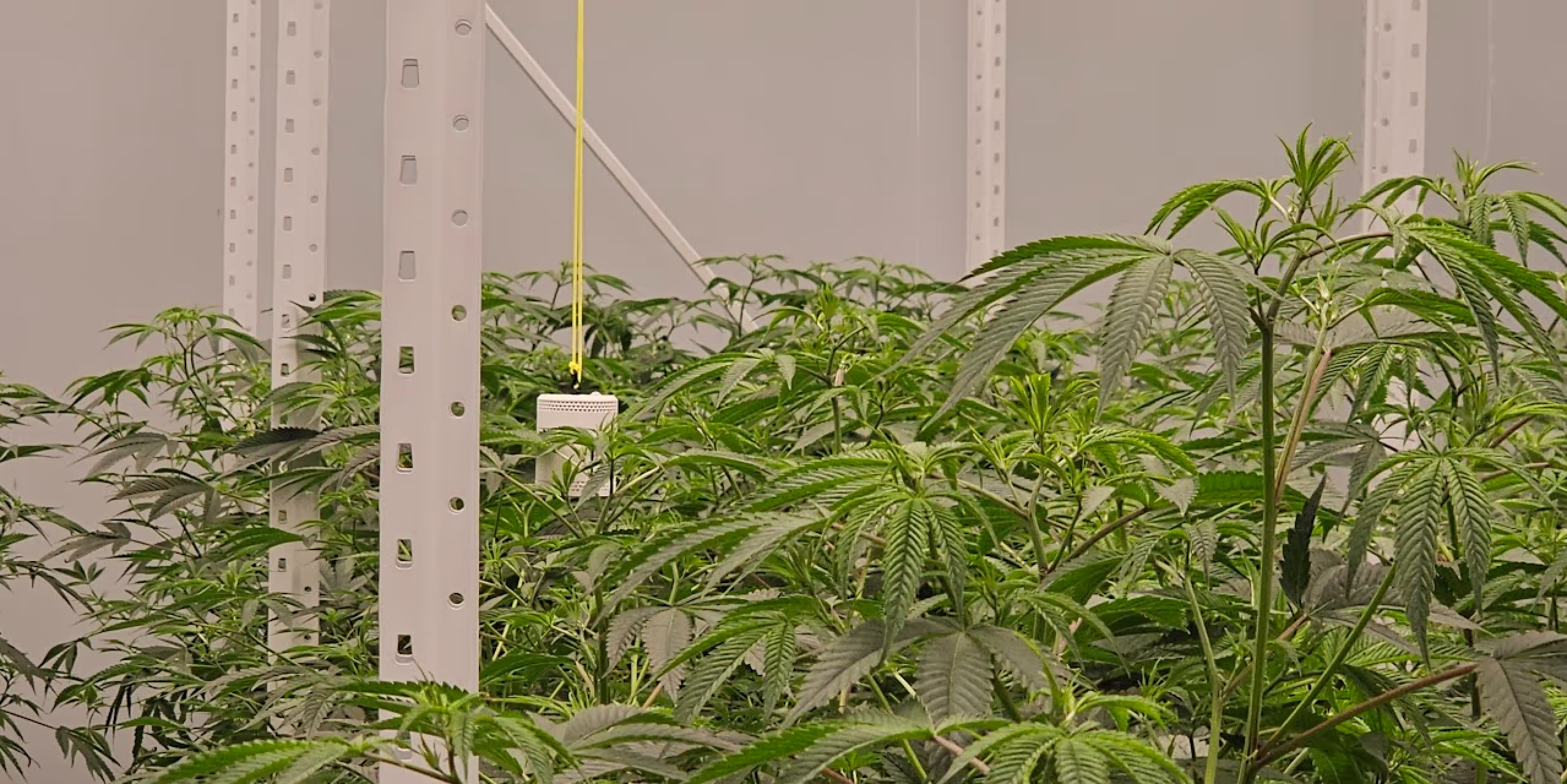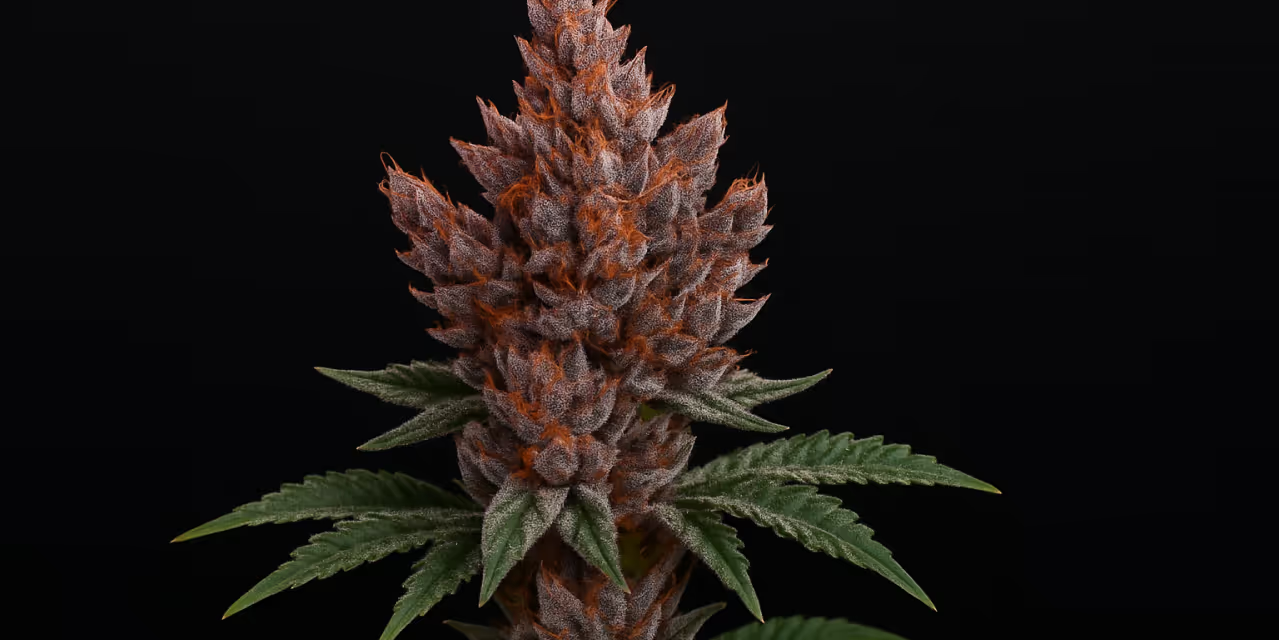Amber trichomes: Key to perfect harvest timing


Are you risking your entire harvest by not understanding amber trichomes?
As a grower, mastering the timing of your cannabis harvest is crucial, and amber trichomes hold the key.
If you harvest too early or too late, you could miss out on the peak potency and flavour of your cannabis plants right at the last minute.
Timing harvesting cannabis wrong can result in low THC levels and a less enjoyable experience.
You might end up with buds that are weak or too sedative, missing the desired effects of your chosen strains. Don't let all your hard work go to waste at harvest time.
This guide provides the solutions that cannabis growers need, helping you avoid common pitfalls and ensuring a successful harvest.
Disclaimer: Any information given on this site is for educational purposes only. Please ensure if you’re growing cannabis, you’re doing so by the law and subject to appropriate permissions and licenses of the applicable country.
What are trichomes on a cannabis plant?
Cannabis trichomes are tiny glandular structures or resin glands on the surface of cannabis plants that produce resin.
They look like tiny hairs and are most abundant on the buds of female cannabis plants, as well as on sugar leaves and, to a lesser extent, other cannabis leaves.
Trichomes serve multiple purposes, including protecting the plant from pests and UV rays and attracting pollinators.
During the flowering phase, these resin glands on your cannabis flowers are where the magic happens.
Trichomes are the primary source of cannabinoids and terpenes that give cannabis its unique properties.
Cannabis growers need to understand the different stages of cannabis trichome development to time their harvest correctly.
Cannabis trichomes found come in several types, each with distinct characteristics:
Bulbous trichomes
Bulbous trichomes are the smallest trichomes, measuring only about 10-15 micrometres in diameter.
Despite their small size, bulbous trichomes play a vital role in the plant's defence mechanisms. The swollen head of these glandular trichomes contains medicinal compounds and desirable cannabinoids.
Capitate sessile trichomes
Capitate sessile trichomes are larger than bulbous trichomes. These glandular trichomes are more visible and can be found on the surface of leaves and stems.
They have a stalk and a head, where the resin is produced. Capitate sessile trichomes are particularly significant during the cannabis plant's flowering stage.
Capitate stalked trichomes
Capitate stalked trichomes are the largest and most abundant in cannabis flowers. These trichomes are the primary source of cannabinoids and terpenes.
They have bulbous trichome heads and a long stalk, making them easy to spot with a magnifying glass. Capitate stalked trichomes are crucial for determining the potency and quality of the cannabis bud.
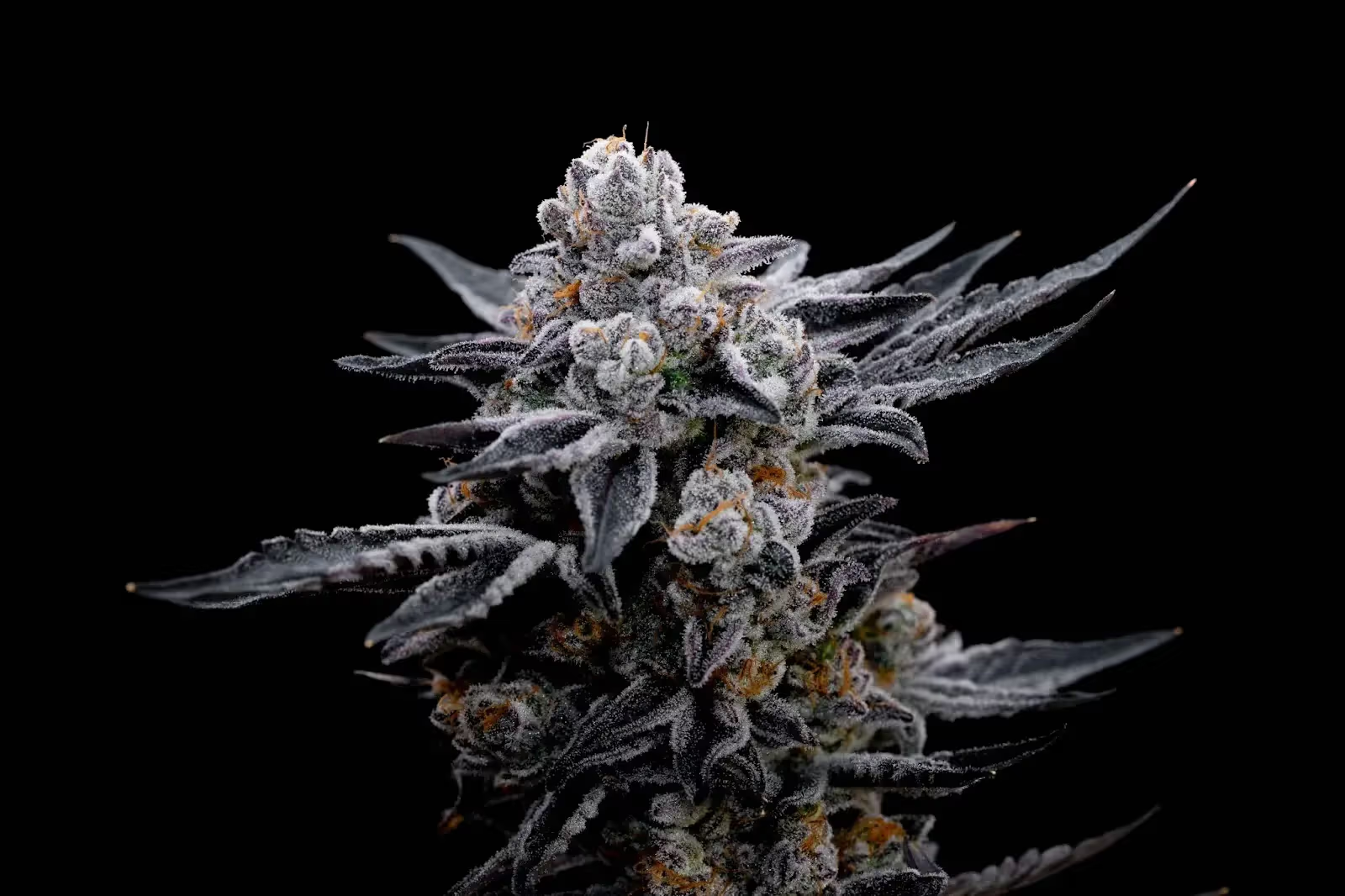
The development of trichomes on female cannabis plants
From the moment cannabis seeds sprout, the plants begin the journey toward producing trichomes.
As female cannabis plants mature, cannabis trichomes transition through various stages, from clear to milky to amber.
This progression is a vital part of the glandular trichome development process and is closely linked to the plant's overall maturity and potency.
The colour of cannabis trichomes is the best indicator of your plant’s readiness for harvest.
Understanding these colour stages is essential for timing your harvest to achieve the desired effects and maximise the potency of your cannabis plants.
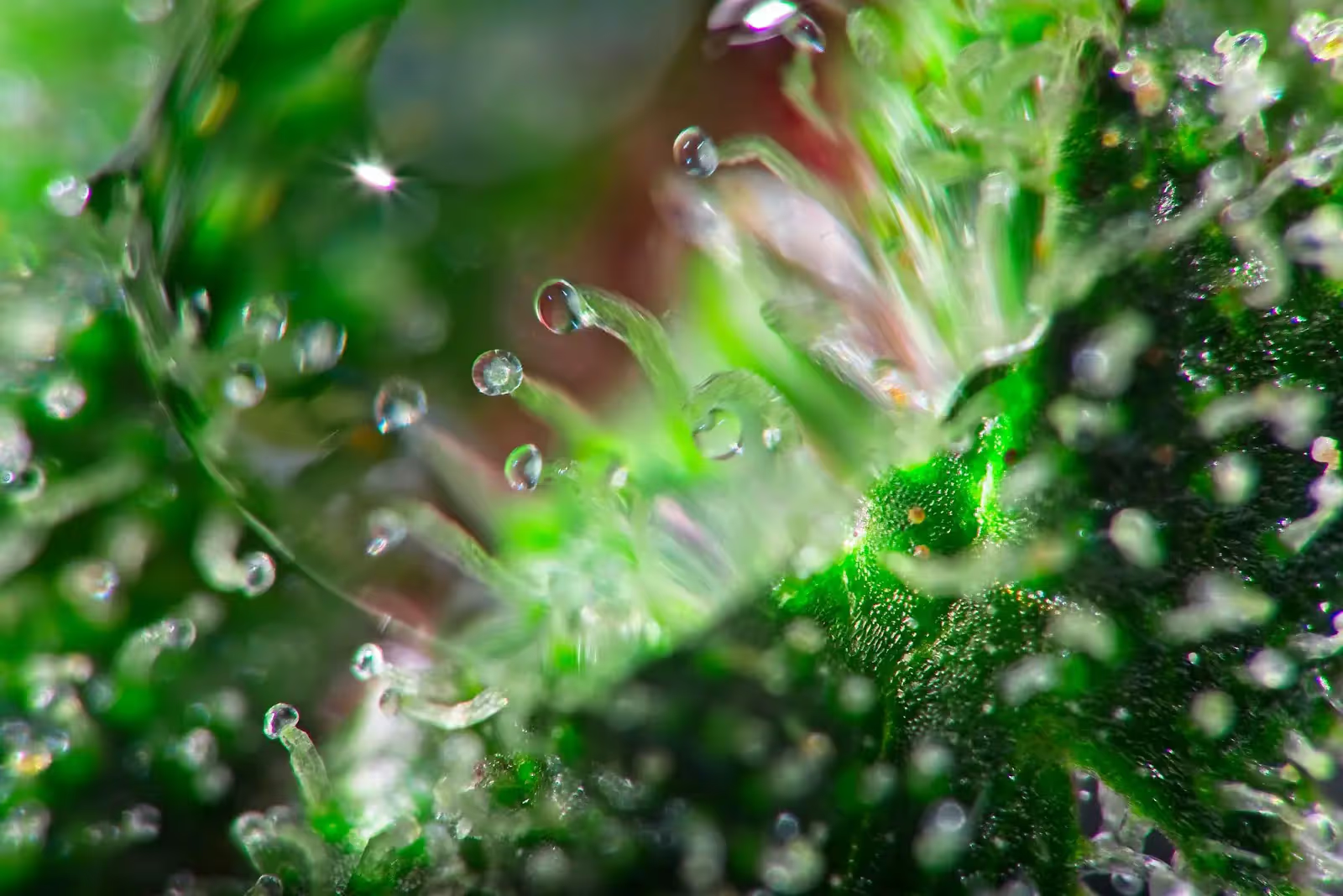
Clear trichomes
You'll notice clear trichomes at the beginning of the trichome development process. These indicate that the plant is still maturing. At this stage, trichomes are fully formed but not yet potent.
The resin within them is still developing, and the THC levels are relatively low. Clear trichomes are a sign that your cannabis plant needs more time to develop its cannabinoids and terpenes.
- Resin glands at this stage are immature, and the plant's effects are minimal.
- The plant is still in the early stages of the flowering process.
- Cannabis cultivators need to wait before considering their plants ready to harvest.

Milky or cloudy trichomes
As the plant matures, trichomes transition to a milky or cloudy appearance. This stage shows that the plant is nearing its peak potency.
The cloudy trichomes indicate high THC levels, which many growers prefer for their energetic and uplifting effects. This is a critical stage in the harvest window.
- Cloudy trichomes signal that the plant is at its most potent.
- The plant's cannabinoids and terpenes are at optimal levels.
- Harvest timing: When trichomes turn from clear to milky.
You should harvest when most trichomes are milky for a more uplifting effect. This stage is preferred by those looking for an energetic and cerebral high.
- Benefits: Energetic, cerebral high, ideal for daytime use.
- Preferred by: Many cannabis growers who seek a more stimulating effect from their cannabis.
Wait until you see a mix of milky and amber trichs for a balanced effect. This stage provides a combination of both uplifting and relaxing effects, suitable for a well-rounded experience.
A mix of milky trichomes and amber trichomes indicates that your cannabis is at peak ripeness, offering a blend of both energising and calming properties.
- Harvest timing: When there is a significant presence of both milky and amber trichomes.
- Benefits: Cannabis harvested now will have a balanced high, combining both uplifting and relaxing effects.
- Preferred by: Those looking for a versatile cannabis experience suitable for any time of day.
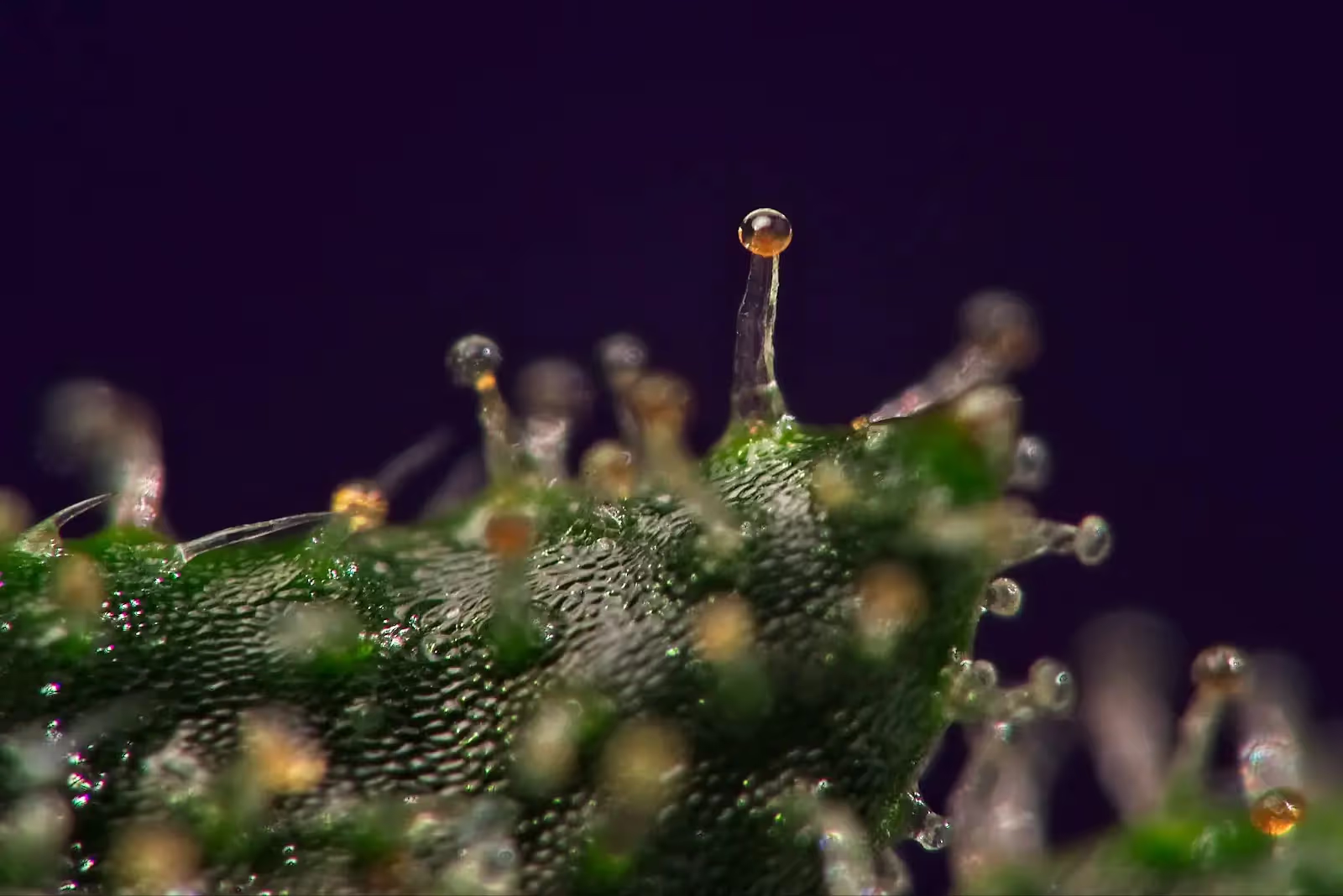
Amber trichomes
Finally, all the trichomes become amber, signifying that the plant is reaching or has reached its maximum potency.
Amber trichomes indicate a more mature plant that is ready to harvest. The effects will be more sedative, perfect for those seeking a calming, couch-lock experience.
- Amber trichomes from a later harvest provide a narcotic, couch-lock effect.
- This stage is best for those seeking a sedative or relaxing effect.
- It's crucial to monitor trichomes closely to avoid overripe cannabis buds.
- Harvest timing: When the majority of trichomes have turned amber.
Amber trichomes signify that the THC is beginning to degrade into CBN (Cannabinol), which has more narcotic, sedative effects.
- Benefits: Relaxing, sedative effects, perfect for evening use.
- Preferred by: Cannabis harvested later is better for medicinal users or those seeking a calming, couch-lock experience.

Monitoring trichomes for the ideal harvest window
Your personal preference dictates when your plants are ready to harvest. For a more balanced high, aim for a mix of milky and amber colour trichomes.
If you prefer a more energetic effect, harvest when the trichomes are mostly cloudy. For a more sedative effect, wait until most trichomes have turned amber.
Monitoring the colour of trichomes is essential for timing your harvest perfectly. This careful observation ensures that you harvest at the right moment to achieve the best potency and desired effects from your cannabis strains.
Want more canna-insights? Sign up for the Grow The Best newsletter now!
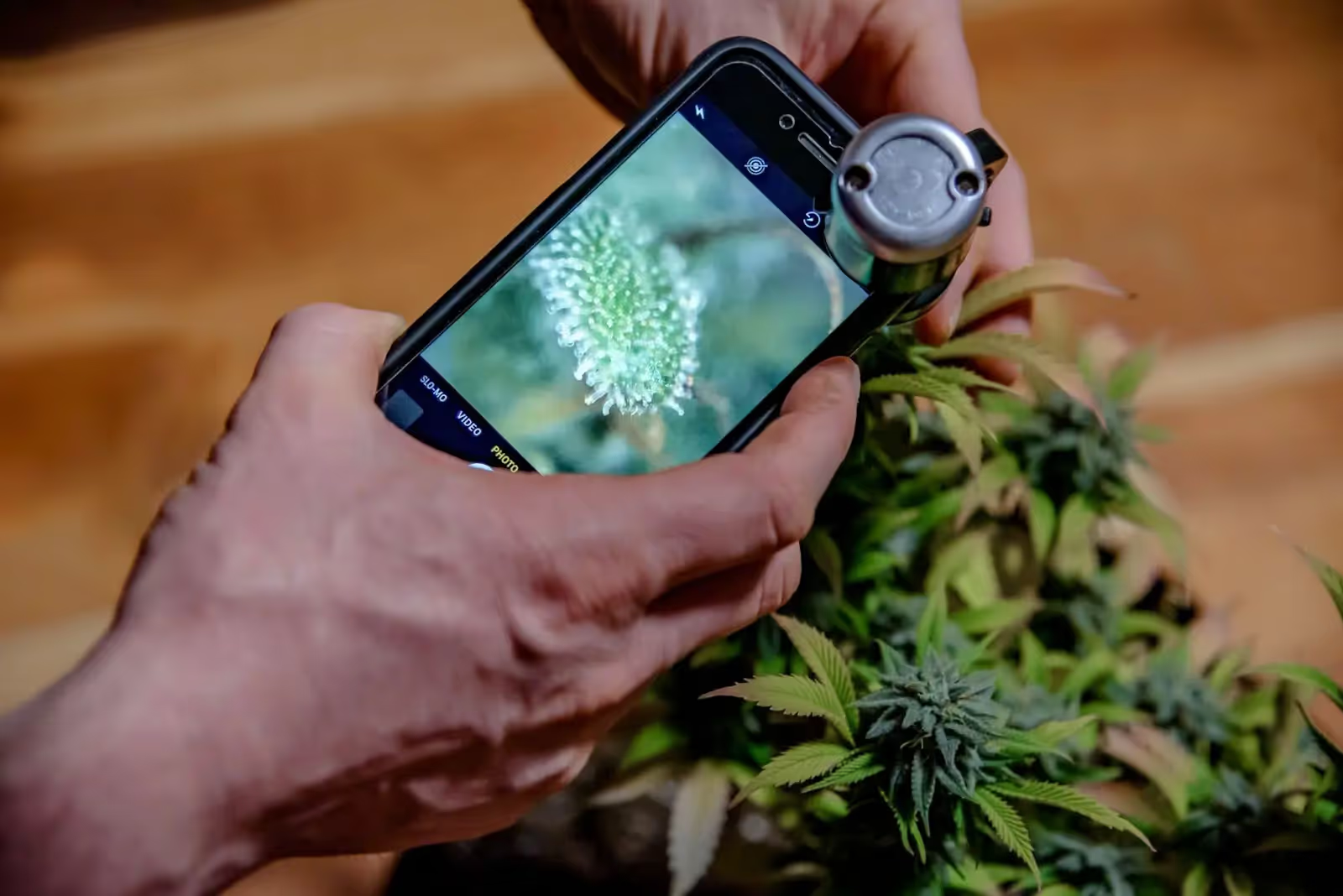
The best tools for trichome inspection
Accurately assessing cannabis trichome development is crucial for determining the optimal time to harvest cannabis plants, and the naked eye really isn’t good enough.
To do this, you'll need a few essential tools that allow you to closely inspect the tiny structures on your cannabis flowers and make an informed decision about the best time to harvest.
Here's a closer look at the tools you should use:
Magnifying glass
A magnifying glass is a basic yet effective tool for getting a closer look at trichomes. While it offers minimal magnification, it can be useful for a quick check of the trichomes' general appearance.
- Benefits: Easy to use and readily available.
- Usage: This is ideal for preliminary inspections to determine whether trichomes are clear, milky, or starting to go amber.
- Limitations: May not provide enough detail for precise assessment.
Jeweller’s loupe
A jeweller’s loupe offers higher magnification, usually around 30x. This portable tool lets you see the trichomes in more detail, making it easier to distinguish between clear trichomes, milky trichomes, and amber trichomes.
- Benefits: High magnification, portable, and relatively inexpensive.
- Usage: Perfect for regular inspections and determining the precise stage of trichome development.
- Limitations: Requires a steady hand and good lighting to use effectively.
Digital microscope
A digital microscope provides detailed images and often connects to your phone or computer for easy viewing. This tool offers the highest magnification and clarity, making distinguishing between the different stages of trichome development easier.
- Benefits: Highest magnification, detailed images, and ability to save and compare images over time.
- Usage: Ideal for in-depth analysis and documentation of trichome stages.
- Limitations: It is more expensive and requires some setup and technical knowledge.
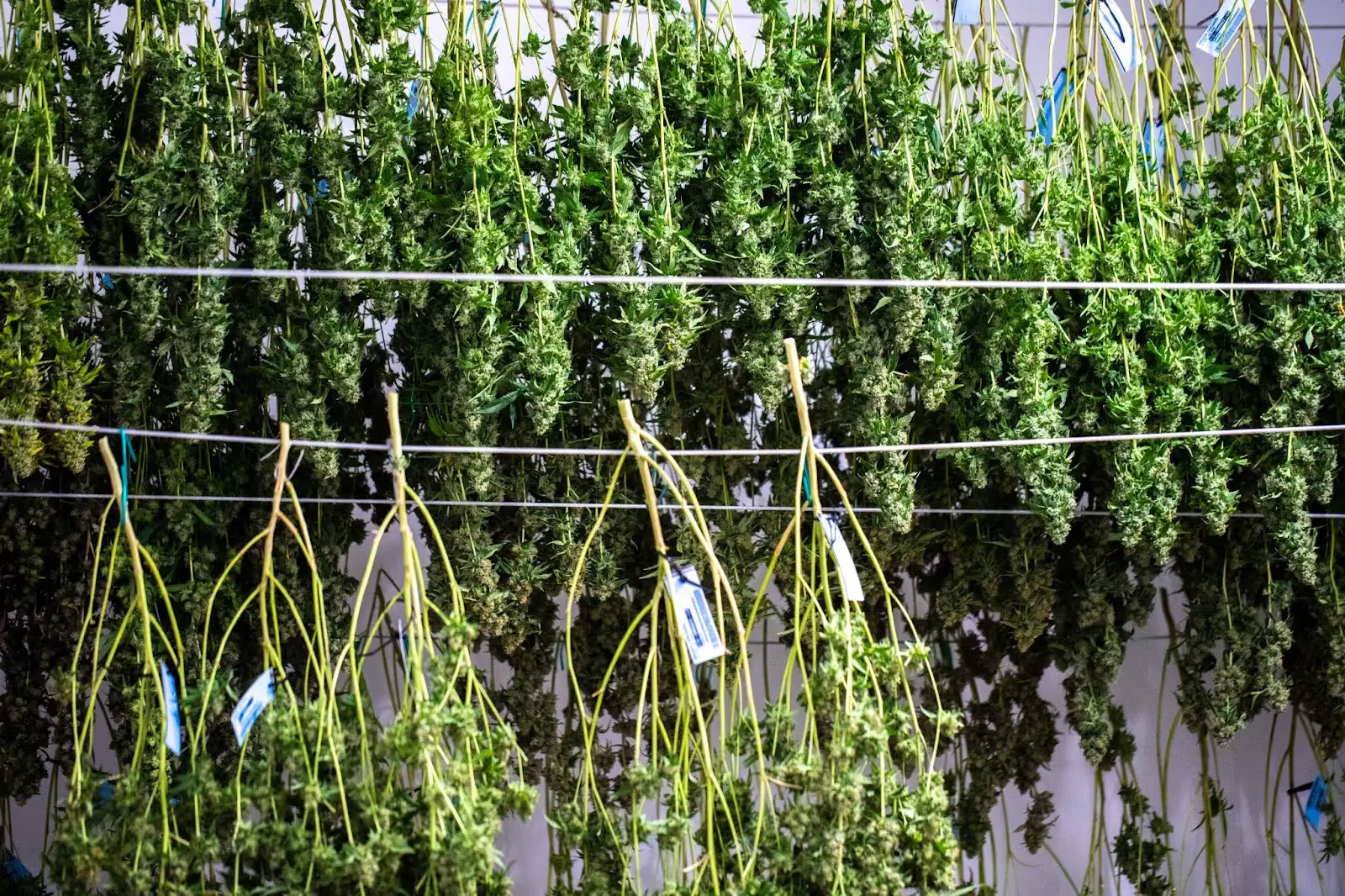
Practical tips for timing your harvest
Regular inspection
Check trichomes daily as your plant nears the end of the flowering phase, and wait until all the pistils have darkened before considering harvest.
Use the right tools
A magnifying glass, jeweller's loupe, or digital microscope will help you see the trichome colours clearly.
Document changes
Take notes or pictures of trichomes daily to monitor their development and ensure you don't miss the perfect harvest window.
By understanding the different stages of trichome development and knowing what each colour signifies, you can make an informed decision about when to harvest your cannabis plants.
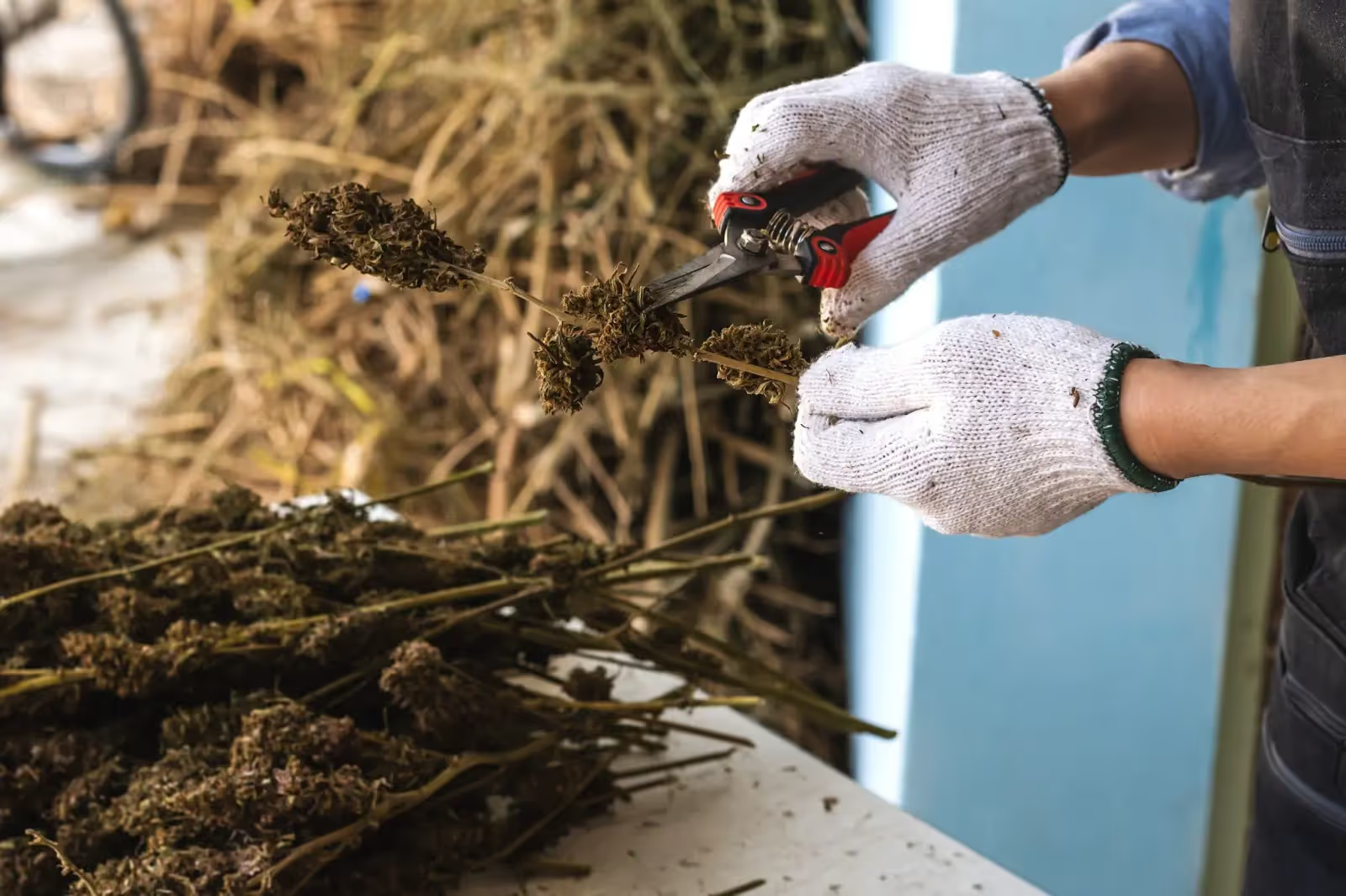
Harvesting time
When you’ve determined that your cannabis is ready to harvest (when white hairs on the buds start to darken), follow these steps for the best harvest:
- Cutting: Use sharp scissors to cut the branches. Be careful to avoid damaging the buds and trichomes.
- Drying: Hang the branches upside down in a dark, cool, ventilated space. This process usually takes about a week but can vary depending on the environment.
- Curing: After drying, place the buds in glass jars for curing. This process enhances the flavour and potency of your cannabis. Burp the jars daily for the first week to release moisture and then less frequently over the next few weeks.
Want to learn more about drying and curing? Check out drying and curing for beginners and how the world's top growers are drying & curing cannabis.
Inspect the trichomes throughout each harvesting stage to ensure you’re preserving the maximum potency and flavour.
Proper drying and curing will significantly improve the quality of your final product.
Join the Grow The Best newsletter for top growing tips and tricks!

Common problems and solutions
As a grower, you may encounter issues where cannabis trichomes do not turn amber as expected.
This could be due to a few factors, such as strain genetics, environmental conditions, or even nutrient deficiencies affecting the development of cannabis flowers.
Understanding these common problems and their solutions can help you adjust your growing conditions and ensure a good harvest.

Heat stress
This is a common issue that can affect trichome development. High temperatures can cause trichomes to remain clear or milky, delaying the transition to amber.
To prevent heat stress, ensure your grow space is well-ventilated, and the temperature is kept within optimal ranges.
- Solution: Maintain a stable temperature between 20-28°C (68-82°F) or up to 30°C (86°F) if supplementing with CO2. Use fans and proper ventilation to keep air circulating and prevent hot spots.

Cold temperatures
Cold temperatures can also impact trichome maturation. If the growing environment is too cold, it can slow down the flowering process and affect the development of amber trichomes.
Keeping your plants in a stable environment promotes healthy trichome development.
- Solution: Ensure the daytime temperature does not drop below 18°C (64°F) during the flowering stage. Use heaters or insulation to maintain a consistent temperature in your growing space.
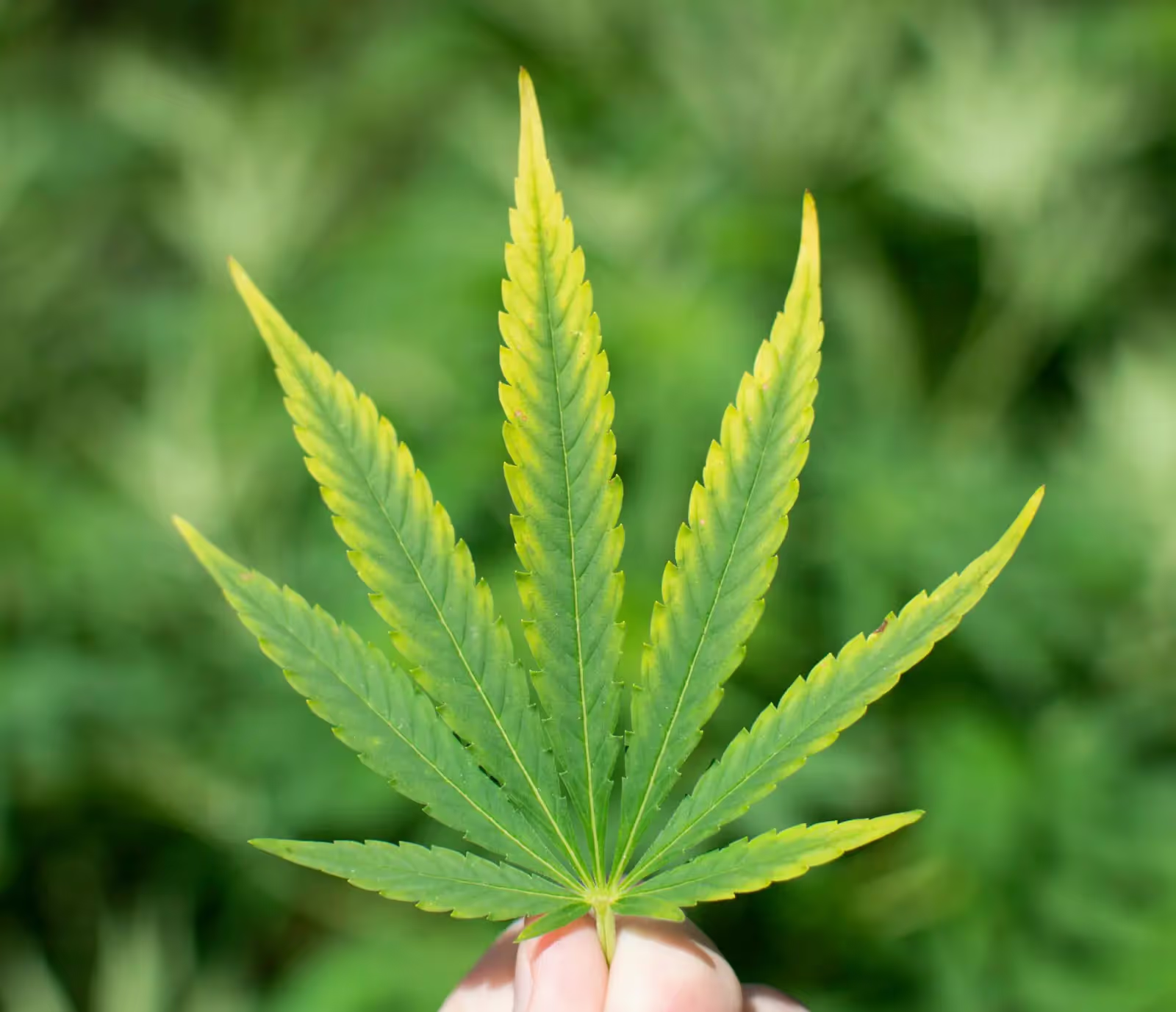
Nutrient deficiencies
Nutrient deficiencies can hinder trichome production and prevent them from turning amber.
Plants require a balanced diet of nutrients to develop correctly, and any imbalance can affect their growth and the quality of the trichomes.
Monitor for yellow leaves, which can indicate nutrient deficiencies affecting trichome development.
- Solution: Follow a balanced feeding schedule that includes essential nutrients such as nitrogen, phosphorus, and potassium. Consider using supplements that promote trichome development, such as silica and magnesium.
Additional factors
Your cannabis strains' genetic
Strain genetics play a significant role in how trichomes develop. Not all plants will develop amber trichomes at the same rate due to genetic differences.
Understanding the genetic profile of your strain can help set realistic expectations for trichome development.
- Solution: Research your strain's specific needs and characteristics. If amber trichomes are your priority, select strains known for robust trichome production.
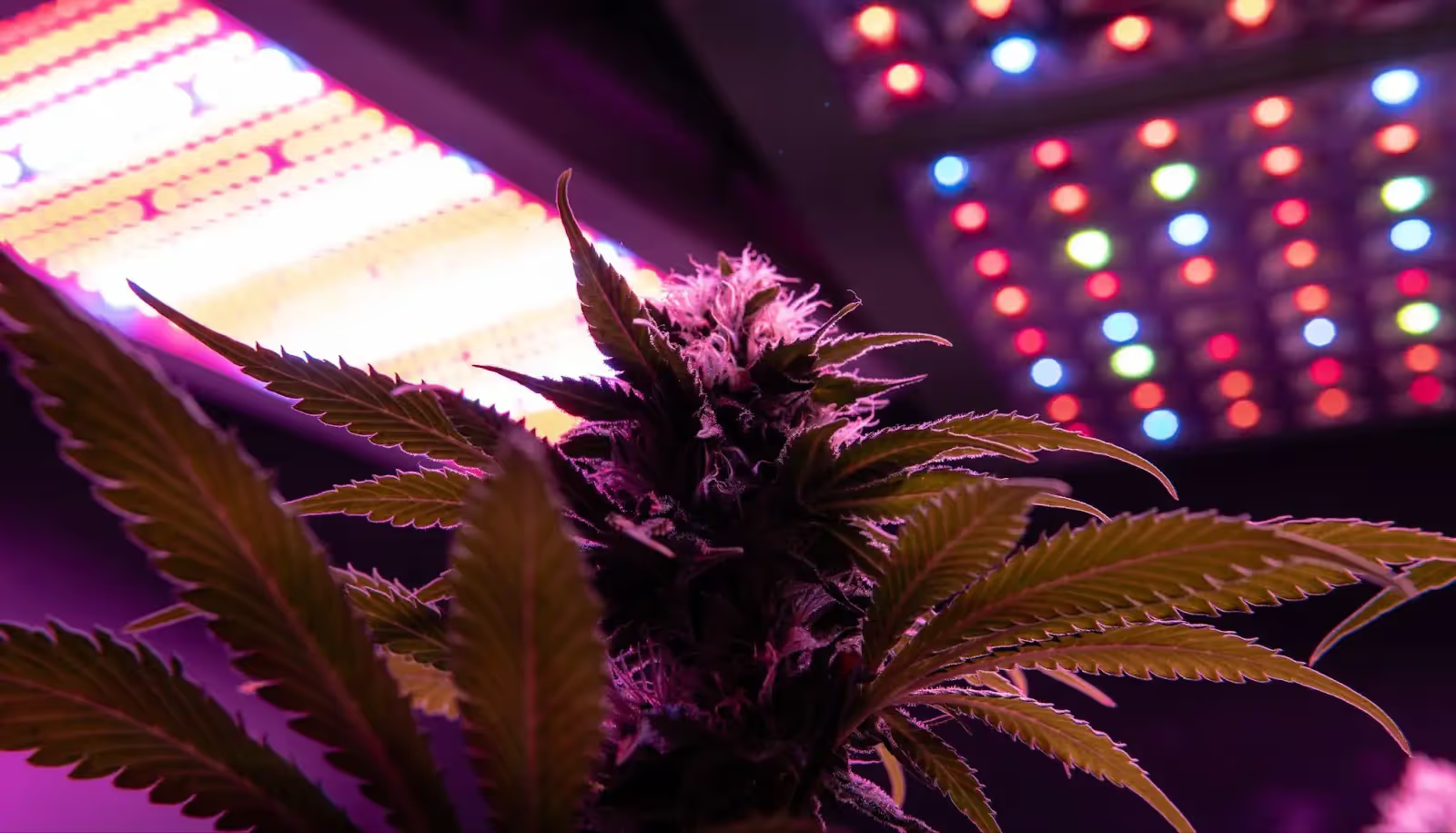
Light stress
Light stress can also affect trichome maturation. Both excessive and insufficient light can disrupt the flowering stage and impact trichome colour.
- Solution: Ensure your plants receive the right amount of light. You can always remove some fan leaves to allow more light to get to the buds. Use a light meter to monitor light levels and adjust as needed. Aim for consistent light exposure without extreme fluctuations.
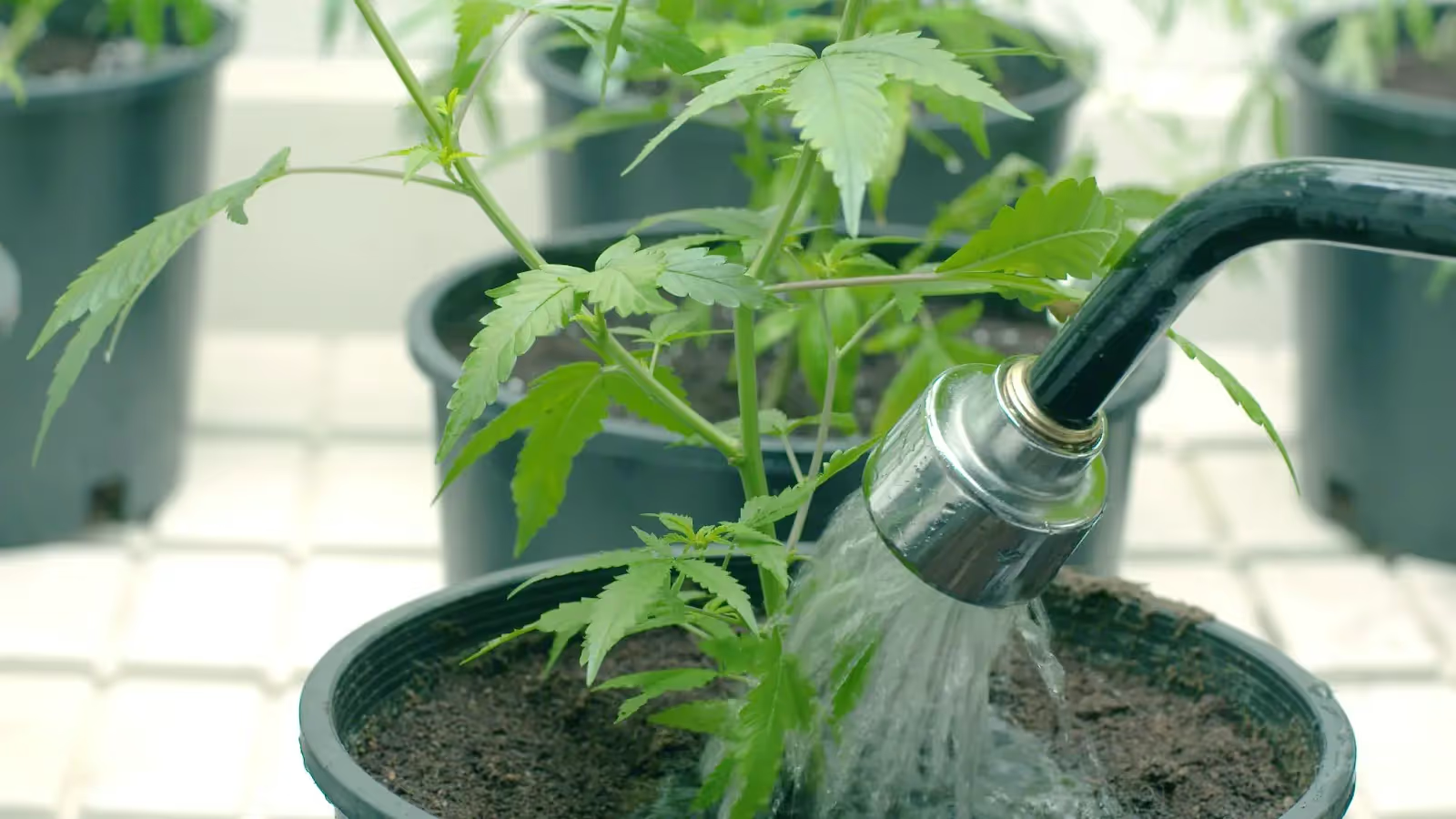
Watering practices
Improper watering practices can lead to stress and affect trichome development. Overwatering or underwatering can cause stress, impacting the plant's ability to produce amber trichomes.
- Solution: Maintain a consistent watering schedule. Allow the top inch of soil to dry out before watering again, or use a cannabis soil moisture meter for more accuracy.
Ensure good drainage to prevent root rot and other water-related issues. Bud rot caused by high humidities can destroy trichomes and affect the quality of your harvest.

Monitoring and adjusting conditions
Regularly monitoring your growing conditions is vital for identifying and addressing trichome development issues.
Use tools like grow room sensors, thermometers, hygrometers, and light meters to monitor your environment.
Practical tips
- Regular inspections: Regularly check your plants for signs of stress or deficiencies. Look at the fan leaves, trichomes, and overall plant health.
- Document changes: Keep a grow journal (journal feature coming to the Grow Sensor soon!) to document changes and any adjustments you make. This helps you track progress and identify patterns.
- Adjust accordingly: Be ready to make adjustments based on your observations. Small changes in temperature, light, or nutrients can make a significant difference.
By addressing these common issues and implementing the suggested solutions, you can promote healthy trichome development.
Regular monitoring and adjustments will help you create the optimal growing environment for your cannabis plants, leading to high-quality, potent buds with the desired amber trichomes.
Takeaways:
Understanding the nuances of cannabis trichome development and the impact of different trichome colours on the effects of your cannabis will empower you to make informed decisions and lead to a successful harvest.
Properly monitoring trichome development on female cannabis plants ensures growers harvest at peak potency.
Achieving the perfect harvest involves patience, observation, and the right techniques. Focusing on the development and colour of your trichomes can maximise the potency and desired effects of your cannabis plant.
Regularly inspect your cannabis plant using the appropriate tools, and be proactive in managing your growing conditions to support healthy trichome development.
With these insights, you'll be able to produce high-grade cannabis that meets your preferences and needs.
Remember, the key to a successful harvest lies in the details. Take your time, observe your plants carefully, and adjust your methods as needed. By doing so, you’ll ensure a happy harvest and enjoy the rewards of your diligent efforts.
Happy growing!
FAQs
What do amber trichomes mean?
Amber trichomes indicate that your cannabis plants have reached peak maturity and are ready for harvest.
This stage signifies a shift in the colour from milky to amber, suggesting that the THC levels are beginning to degrade into CBN (Cannabinol).
This degradation results in a more sedative, narcotic effect, ideal for those seeking a calming, couch-lock experience.
If you prefer relaxing and medicinal properties, harvesting when most trichomes have turned amber will yield the desired results.
Regularly inspecting trichomes on cannabis flowers with a magnifying glass or jeweller’s loupe ensures you don’t miss this crucial harvest window.
Which trichomes turn amber first?
In cannabis plants, the capitate stalked trichomes are typically the first to go amber.
These trichomes are the largest and most abundant on cannabis buds, making them the primary indicators of maturity.
Capitate stalked trichomes have a bulbous head and a long stalk, which are easily visible with a magnifying glass or jeweller’s loupe.
As the plant matures, these trichomes transition from clear to milky trichomes and finally to amber, indicating peak potency and readiness for harvest. Monitoring these trichomes closely during the flowering stage helps determine the optimal harvest window.
Can I harvest with some clear trichomes?
While it is possible to harvest with some clear trichomes, it is generally not recommended if you are aiming for maximum potency and desired effects.
Clear trichomes indicate that the plant is still maturing, and the THC levels are not yet fully developed. Harvesting at this stage can produce a less potent product with a weaker, less desirable effect.
However, if your goal is to achieve a very mild and potentially more energetic high with lower THC content, you might consider harvesting when a small percentage of trichomes are still clear.
For the best results, most cannabis growers prefer to wait until the majority of trichomes have turned milky or amber, indicating peak ripeness and potency.
Should I harvest when trichomes are amber?
Yes, you should consider harvesting your cannabis plants when the trichomes are amber if you seek a more sedative and relaxing effect.
Amber trichomes indicate that the plant has reached peak maturity, and the THC levels are starting to degrade into CBN (Cannabinol), which has a more narcotic, couch-lock effect.
Can you harvest with no amber trichomes?
Yes, you can harvest with no amber trichomes, but it depends on the effects you want from your cannabis plant. Milky trichomes indicate peak THC levels and provide a more energetic and uplifting high.
Harvesting when trichomes are predominantly milky will give you a more cerebral and stimulating effect, which many cannabis growers prefer for daytime use.
However, if you seek a more relaxing sedative effect, waiting until some trichomes turn amber is better. Amber trichomes indicate that THC is beginning to degrade into CBN, which has more narcotic, calming effects.
How long does it take for trichomes to turn amber?
The transition of trichomes from clear to amber on cannabis plants typically takes several weeks, often occurring over a span of 4 to 8 weeks during the flowering stage.
What percentage of trichomes turn amber?
The percentage of amber trichomes you aim for depends on the desired effects of your cannabis.
Generally, growers wait for about 20% to 30% of the trichomes to turn amber before harvesting. This percentage indicates a balance between the plant's peak THC levels and enough amber trichomes to provide a more sedative, relaxing effect.
For those seeking a more energetic and uplifting high, harvesting when trichomes are mostly milky, with only a few starting to go amber (around 10-20%), is ideal.
Conversely, if you prefer a strong sedative effect, wait until 50% or more of the trichomes have turned amber.
Are amber trichomes more potent?
Amber trichomes are not necessarily more potent in terms of THC levels. In fact, when trichomes go amber, it indicates that the THC is starting to degrade into CBN (Cannabinol). While CBN has its own benefits, such as providing a sedative and calming effect, it has less psychoactive effects than THC.
Therefore, if you're looking for maximum THC potency, harvesting when trichomes are mostly milky is ideal. Milky trichomes indicate peak THC levels and offer a more energetic and uplifting effect.
However, if you prefer a more relaxing, narcotic effect, amber trichomes are beneficial. They provide a couch-lock experience, which can be ideal for evening use or medicinal purposes such as pain relief and insomnia.
What do over ripe trichomes look like?
Overripe trichomes are those left on the cannabis plant past their optimal harvest window. They typically appear dark amber or even brown.
When trichomes reach this stage, the THC levels have significantly degraded into CBN (Cannabinol), resulting in a strong sedative effect that may be too narcotic for some users.
Characteristics of overripe trichomes include:
- Colour: Dark amber to brown, indicating advanced degradation.
- Appearance: Often look shrivelled or collapsed compared to the plump, vibrant trichomes seen at peak ripeness.
- Effect: Provides a very sedative, couch-lock effect, which may be desirable for those seeking strong relaxation or medicinal benefits.
-
Why won't trichomes turn amber?
Trichomes may not go amber due to strain genetics, environmental conditions, light exposure, and nutrient deficiencies.
Some cannabis strains naturally take longer to develop amber trichomes. High temperatures or cold stress can disrupt trichome development, and improper light levels can also affect maturation.
Additionally, nutrient deficiencies may hinder the transition to amber. Regular monitoring and maintaining optimal growing conditions can help encourage trichomes to become amber.
Enhance your gardening skills – subscribe to the Grow The Best newsletter today!











.avif)


